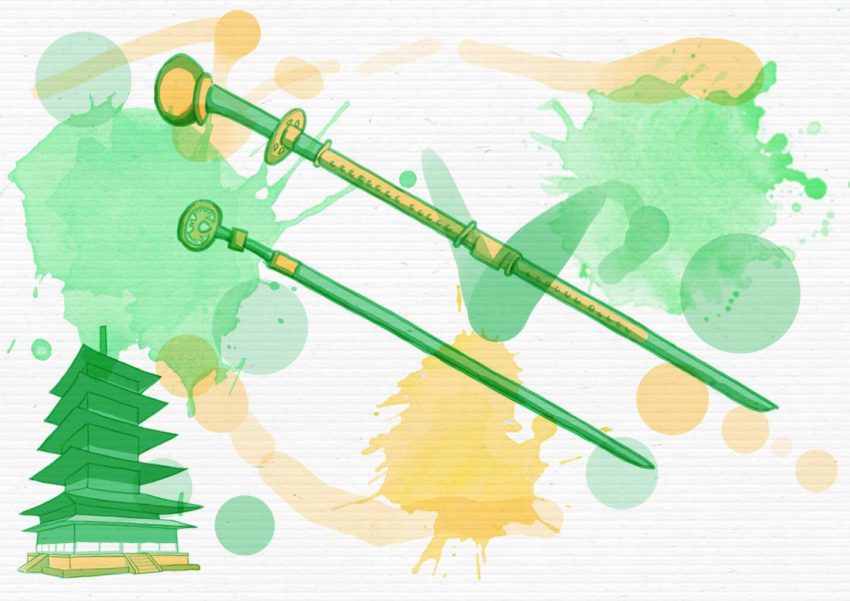If you’re both a fan of the popular PBS program Antiques Road Show, and your fascination with antique Japanese swords made and used before 900 AD is unbounded, then watching and waiting for a guest to bring forth one of these antique treasures could keep you glued to your TV.
Given the time period that’s of most interest to antique sword lovers, those being evaluated that represent later Japanese eras may leave you disappointed, but keep watching. Patience is a virtue and you’re all about the challenge of finding these gems, no matter how long it takes, especially if you’re just being introduced to this exotic hobby.
Origins of Antique Japanese Swords: Jokoto
Antique swords from what is now Japan have unique characteristics that set them apart. These deadly, artful weapons are separate from those crafted later because they were straight rather than curved. This distinction is important because it can help you verify the age of a sword you are considering, but whose authenticity you aren’t quite sure of.
Look for swords classified as chokutoCHOKUTO 直刀 "straight sword" learn more... or kenKEN 剣 "sword [non-Japanese]" learn more... to winnow down a search, so you consider only swords made before the samurai became Japan’s ruling class. If you can find a sword made in Yamato, Mutsu or San-in Provinces you may have unearthed the work of one of the era’s few swordsmiths.
Because the earliest Japanese swords were based on weapons made in China or Korea, they were subject to rudimentary manufacturing processes, tending to be poorly made and easily broken. Artisans hammered ridgeless slabs of molten metal into shape, honing pointed tips designed to “stab and thrust,” which was the primary combat style around 900 AD.
Types of Antique Japanese Swords
Japanese sword craftsmanship was elevated to high art after the tenth century, so your sword choices are usually limited to:
- ChokutoCHOKUTO 直刀 "straight sword" learn more...: Straight sword, made without folding or hardening during the fabrication process.
- TsurugiTSURUGI 剣 "sword [non-Japanese]" learn more.../KenKEN 剣 "sword [non-Japanese]" learn more...: Two-edged swords, manufactured prior to the 10th century. Some were made using folding techniques. Others were subject to differential hardening.
- TachiTACHI 太刀 "great sword" learn more...: Long sword that introduced the curved blade. These weapons were worn suspended from a sash or belt, the sharp edge facing downward.
- Also popular: KodachiKODACHI 小太刀 "small tachi sword" learn more..., often called “small tachi” due to its more diminutive size.
Other Japanese weapons classified as swords:
- The nagamaki sword gets its name from its wrapped handle atop a straight blade.
- Warriors used yariYARI 槍 "spear or lance" learn more... (spears) to hunt prey thanks to a double-edge flat blade and triangular cross section.
- Known as a “short sword,” the tantoTANTO 短刀 "short sword" learn more... traditionally features a single edge, but double-edge versions can be found.
- Ceremonial or religious swords are usually called kenKEN 剣 "sword [non-Japanese]" learn more.... They are typically identified by a leaf shape and at times, decorative patterning.
How Antique Japanese Swords Were Made
At the Metropolitan Museum of Art, a display of ancient Japanese swords is one of the institution’s biggest attractions. The museum offers a lengthy explanation of sword manufacture that covers these salient points:
- The crafting of swords was not to be taken lightly. The process was subtle, careful and deliberate, evolving over time to increase tensile strength and develop specific styling for unique uses.
- Artisans were required to be physically strong, patient, and dexterous. They had to possess an aesthetic that treated sword crafting as a serious art.
- Early swords were crafted with a type of steel known as tamahaganeTAMAHAGANE 玉鋼 "jewel steel" learn more..., an iron-rich material found in Asia.
- Craftsmen used a folding technique called kitaeKITAE 鍛え "forge" learn more... to work out steel impurities. Though the many layers can’t be seen with the naked eye, 14 folds produced 16,000 layers.
- During the edge-hardening stage, a mix of ash, clay, water and other agents were used to coat blades. Some of these coating recipes were kept secret by their inventors.
- Firing temperature was a critical component of sword production. The chemical properties of steel change only after temperatures reach about 1,400°F, at which point immediate cooling is required to freeze the steel’s hard edge.
7 Ways to Find Antique Japanese Swords For Sale
For devoted collectors of ancient artifacts, part of the fun is displaying a rare find on a wall or stand, but for others the hunt offers the most pleasure and excitement. One or more of these ideas is likely to become your favorite.
- A great place to start your search is online, using sales sites to define your interest and limit the search to Japanese swords made before 1000 AD.
- Make the ultimate sacrifice. Fly to Japan and see what you can unearth during your visit there.
- Find authorized dealers specializing in Japanese antiques, especially if they deal in rare ancient sword sales. Check credentials and ask for references.
- Subscribe to a service that gives collectors access to Japanese sword collectors. Finding like-minded people can be a great help because they are already immersed in this world and communities can be strong and helpful.
- Bookmark websites devoted to the specific exploration, education and information conduits that revolve around the international Japanese sword market.
- Join a club focused on Japanese weaponry – either one that conducts regular in-person meetings, or one that exists as a cyber exchange and resource for members.
- Contact appraisers well-versed in the history of Japanese weaponry. Their acumen and experience can be critical when you seek authentification, and it’s worth paying a fee for their services.
Value and Condition Matter
Having made your list of potential resources, it’s good to learn what the market will bear in terms of the actual price of antique Japanese swords – especially if you get into a bidding war with another collector as keen to own a particular sword as you are.
According to some, you should use these estimates to see if your negotiation is in the ball park. (Understand of course that valuations are subject to change at any time.)
- If you come across a long sword (tachi or katana), expect to spend between $2,000 and $5,000 US. The older the authenticated date, the higher the price.
- A medium-size wakizashiWAKIZASHI 脇差 or 脇指 "medium-length sword" learn more... sword in great condition could set you back around $700.
- Shorter tanto-style knives or daggers can be located for around $500.
Go Slow At First, Until You Know the Antique Japanese Swords Market
Richard George, a relatively new Japanese sword enthusiast, cares enough about this market to draft a list of precautions he urges new collectors to read and follow before they set off on their search. Practical advice like this is good to review before trying to actually buy an antique Japanese sword, no matter what type, era, or condition you are thinking of.
One thing is for certain – with some patience, luck, and knowledge, you can find some great pieces, either authentic or modern-day replicas, to fit your collection and your budget. Happy hunting!

